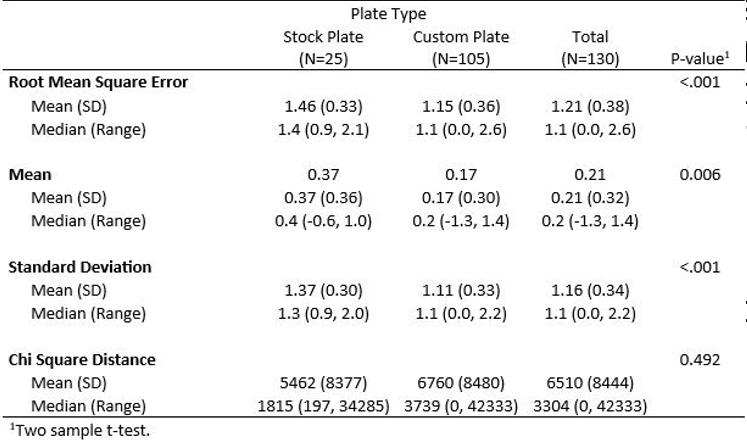Head & Neck
(23) Volumetric accuracy of patient specific vs stock reconstruction plates in mandibular reconstruction with fibular free flaps.
Thursday, September 12, 2024
2:30 PM - 4:00 PM EDT

Ahmed K. Mohamed, BDS
Research Fellow
Mayo clinic
rochester, Minnesota, United States
Kyle S. Ettinger, MD, DDS
Assistant Professor of Surgery
Mayo Clinic
Rochester, Minnesota, United States
Poster Presenter(s)
Co-Author(s)
Disclosure(s):
Ahmed K. mohamed, B.D.S: No financial relationships to disclose
Background: Virtual surgical planning (VSP) utilized for composite microvascular free flaps has become the standard of care for oncologic head and neck reconstruction.1 Despite the widespread adoption of this technology into standard practice, controversy remains as to the use of 3D-printed titanium patient specific implants (PSI) versus hand-contoured stock reconstruction plates.2 Proponents of PSIs cite improved surgical accuracy, reduced operative times, and improved clinical outcomes, whereas detractors purport increased cost associated with PSIs and presumed equivalent reconstructive accuracy with less expensive stock reconstruction plates. 3 This study aims to compare the 3D volumetric accuracy of PSI versus stock reconstruction plates among patients undergoing standard of care VSP for mandibular fibular free flap reconstructions.
Methods: A retrospective study of patients undergoing VSP for fibular free flap reconstructions at Mayo Clinic between 2010 and 2023 was undertaken. Volumetric accuracy of the reconstructions was analyzed by comparing the 3D segmentation of the preoperative surgical plan compared to 3D segmented postoperative surgical outcome from immediate postsurgical CT scans. Accuracy was assessed between pre- and postoperative segmented scans using direct volumetric overlays in CloudCompare software. Root mean square errors (RMSE) were calculated comparing the preoperative and postoperative scans as a quantitative measure of volumetric accuracy. Descriptive statistics comparing demographic and clinical variables also were calculated.
Results: Total of 130 cases were identified for the study including 105 PSI and 25 stock plate cases. Calculated mean RMSE for stock reconstruction plate cases was 1.46 (SD: 0.33) and 1.15 (SD: 0.36) for PSI cases. Univariate modeling demonstrated a statistically significant difference in RMSE value of 0.31 (95% CI: 0.16-0.47) (P < .001) equating to a 23.75% (P = .006) improved volumetric accuracy for reconstructions using PSIs. This association of improved volumetric accuracy with PSIs was maintained in multivariate models controlling for confounding from additional covariates of age, number of fibular segments, preoperative diagnosis, ASA score, Charlson Comorbidity Index (P < .001 for all bivariate models).
Conclusion: In the modern area of head and neck fibular free flap reconstructions using VSP patient-specific 3D-printed titanium implants demonstrate a statistically significant improvement in 3D volumetric surgical accuracy of reconstructions when compared to traditional stock reconstruction plates.Learning objectives:Highlight the difference in volumetric accuracy between patient-specific implants and stock reconstruction plates for fibular free flap reconstruction.Understand the methodology of segmentation overlay and calculation of RMSE in volumetric accuracy between preoperative surgical plan and postoperative surgical outcome.Become familiarized with the process of virtual surgical planning, volumetric segmentation, and use of patient specific 3D-printed titanium implants versus traditional stock reconstruction plates.References 1. Chan A, Sambrook P, Munn Z, Boase S. Effectiveness of computer-assisted virtual planning, cutting guides and pre-engineered plates on outcomes in mandible fibular free flap reconstructions: a systematic review protocol. JBI Database System Rev Implement Rep. 2019;17:2136-2151. 2. May MM, Howe BM, O'Byrne TJ, et al. Short and long-term outcomes of three-dimensional printed surgical guides and virtual surgical planning versus conventional methods for fibula free flap reconstruction of the mandible: Decreased nonunion and complication rates. Head Neck. 2021;43:2342-2352. 3. Yang WF, Choi WS, Leung YY, et al. Three-dimensional printing of patient-specific surgical plates in head and neck reconstruction: A prospective pilot study. Oral Oncol. 2018;78:31-36.
Patient specific implant (PSI) analysis (A) Preoperative VSP (B) Postoperative Segmentation (C) Alignment (D) Distribution of volumetric difference.

Stock Plate analysis (A) Preoperative VSP (B) Postoperative Segmentation (C) Alignment (D) Distribution of volumetric difference.

Associations of plate type with fit characteristics.

